






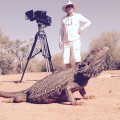
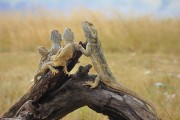
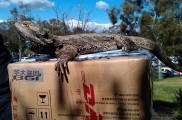
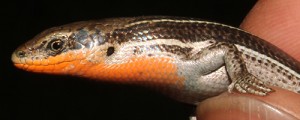
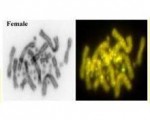
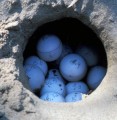


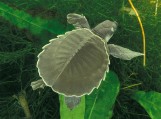

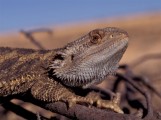
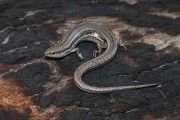

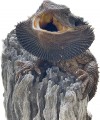
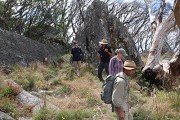


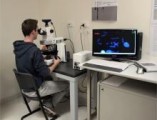



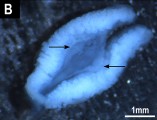

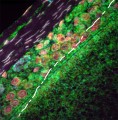


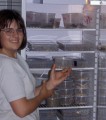
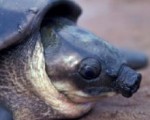


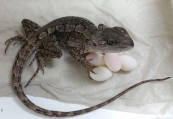
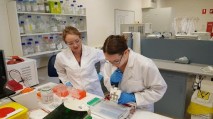
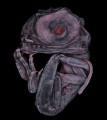
Refereed Publications
- 2025
- 2024
- 2023
- 2022
- 2021
- 2020
- 2019
- 2018
- 2017
- 2016
- 2015
- 2014
- 2013
- 2012
- 2011
- 2010
- 2009
- 2008
- 2007
- 2006
- 2005
- 2004
- 2000
- 1998
- 1994
- 1992
- 1991
- 1989
- 1988
2025
2025. Targeted sequencing and iterative assembly of near-complete genomes. Nature Communications, in press [BioRxiv doi: https://doi.org/10.1101/2025.03.31.646505] [pdf]
2025. A genome assembly and annotation for the Australian alpine skink Bassiana duperreyi using long-read technologies. G3: Genes | Genomes | Genetics, 15:jkaf046 [http://doi.org/10.1093/g3journal/jkaf043] [pdf]
2025. Sex chromosome dosage compensation in a sex reversing skink is not influenced by sexual phenotype. BMC Genomics, in press.
2025. Looping through evolution: divergent 3D genome architecture of spermatogenesis across vertebrates. [submitted, 17-7-25]
2025. A near telomere-to-telomere phased genome assembly and annotation for the Australian central bearded dragon Pogona vitticeps. GigaScience 14:1-19 [http:doi.org/10.1093/gigascience/giaf085] [see also https://doi.org/10.1093/gigascience/giaf079] [pdf]
2025. In vitro organ culture protocol for intact urogenital systems suppsorting gonadal differentiation. PLoS ONE PLoS One 20(7): e0327930. [https://doi.org/10.1371/journal.pone.0327930] [pdf]
2025. Thermal performance curves, activity and survival in a free-ranging ectotherm. Journal of Animal Ecology 94:1823-1836. [pdf]
2025. Establishment of adherent fibroblasts from adult P. vitticeps lung tissue Protocols.io dx.doi.org/10.17504/protocols.io.j8nlkdbj5g5r/v1
2024
2024. Plasticity and the adaptive evolution of switchlike reaction norms under environmental change. Evolution Letters 8:64-75 [https://doi.org/10.1093/evlett/qrad035] [pdf]
2024. Swimming through sand: using accelerometers to observe the cryptic, preemergence life-stage of sea turtle hatchlings. Proc. R. Soc. B 291: 20241702 [https://doi.org/10.1098/rspb.2024.1702]
2024. Partial sex chromosome dosage compensation in a sex reversing skink. [submitted]
2024. Incomplete transcriptional dosage compensation of chicken and platypus sex chromosomes is balanced by post-transcriptional compensation. PNAS
2024. Genetic & Environmental Sex Determination in Cold-Blooded Vertebrates: Fishes, Amphibians, and Reptiles. In: M.K. Skinner (ed), Encyclopedia of Reproduction (Third Edition), Academic Press. doi:10.1016/B978-0-443-21477-6.00193-0 1 [pdf]
2024. Identification of the RSX interactome in a marsupial shows functional coherence with the Xist interactome during X inactivation. Genome Biology 25:134 [https://doi.org/10.1186/s13059-024-03280-0]
2024. Imprinted X chromosome inactivation in marsupials: The paternal X arrives at the egg with a silent DNA methylation profile. PNAS 121(36):e2412185121 [https://doi.org/10.1073/pnas.2412185121]
2024. The genome of the Australian water dragon (Intellagama lesueurii), an agamid model for urban adaptation Journal of Heredity, esae054, https://doi.org/10.1093/jhered/esae054 [pdf]
2024. Genome-wide identification and expression analysis of the STAT family in Reeve’s turtle (Mauremys reevesii). Biochemical Genetics 2024, https://doi.org/10.1007/s10528-024-10820-7 [pdf]
2024. In vitro organ culture of intact urogenital systems supporting gonadal differentiation. protocols.io, doi:10.17504/protocols.io.kqdg3qxj1v25/v1
2024. Unraveling Bird DNAJC15 Gene Evolution via Codon Usage Analysis Submitted
2023
2023. Molecular sex identification for applications in conservation, industry and veterinary medicine. Pp 74-101 (Chapter 8) in Holleley, C.E., Berry, O. and Jarman, S. Applied Ecological Genetics. CSIRO Publishing, Canberra [pdf]
2023. Polygenic sex determination in vertebrates – is there any such thing? Trends in Genetics 39: 242-250. [pdf]
2023. Draft genomes of a male and female Australian jacky dragon (Amphibolurus muricatus). BioXriv [https://doi.org/10.1101/2021.10.11.463868] [pdf]
2023. Gene expression of male pathway genes sox9 and amh during early sex differentiation in a reptile departs from the classical amniote model. BMC Genomics 24:243, https://doi.org/10.1186/s12864-023-09334-0 [pdf]
2023. Three dimensions of thermolabile sex determination. Bioessays 45:e2200123 [https://doi.org/10.1002/bies.202200123] [pdf]
2023. Metabolic consequences of sex-reversal in two lizard species: a test of the like genotype and like phenotype hypotheses. Journal of Experimental Biology 226 (13): jeb245657. [pdf]
2022
2022. Lineage diversity within a widespread endemic Australian skink to better inform conservation in response to regional-scale disturbance. Ecology and Evolution 2:e8627 [pdf]
2022. A male-specific sex marker for the endangered western saw-shelled turtle (Myuchelys bellii) using in silico whole-genome subtraction. Conservation Genetics Resources 14:231–236. [pdf]
2022. Meiotic chromosome dynamics and double strand break formation in reptiles. Frontiers in Cell and Developmental Biology Cell Dev. Biol. 10:1009776 [doi: 10.3389/fcell.2022.1009776]. [pdf]
2022. Impact of fluctuating developmental temperatures on phenotypic traits in reptiles: A meta-analysis. Journal of Experimental Biology 225(Suppl_1):jeb243369 [https://doi.org/10.1242/jeb.243369]
2022. Developmental dynamics of sex reprogramming by high incubation temperatures in a dragon lizard. BMC Genomics 23:322 [pdf]
2022. Truncated jarid2 and kdm6b transcripts are associated with temperature-induced sex reversal during development in a dragon lizard. Science Advances 8:eabk0275 [pdf]
2022. Evolutionary stability inferred for a free ranging lizard with sex-reversal. Molecular Ecology 31:2281-2292.
2022. Sex-specific splicing of Z- and W-borne nr5a1 alleles suggests sex determination is controlled by chromosome conformation PNAS (Proceedings of the National Academy of Sciences USA) 119(4):e2116475119 [pdf]
2022. Diversity of reptile sex chromosome evolution revealed by cytogenetic and linked-read sequencing. Zoological Research 43:719-733 [pdf]
2021
2021. Sex determination mechanisms among populations within cryptic species complex of Calotes (Squamata: Agamidae: Draconinae). DNA 1:49–67 [pdf]
2021. Corticosterone does not have a role in temperature sex reversal in the central bearded dragon (Pogona vitticeps). Journal of Experimental Zoology 335:301-310. [pdf]
2021. Evolving thermal thresholds may explain the distribution of temperature sex reversal in an Australian dragon lizard (Pogona vitticeps). Diversity and Distributions 27:427-438. [pdf]
2021. High altitude increases the risk of Y chromosome loss in Alpine skink populations with sex reversal. Heredity 126:805–816 [pdf]
2021. Effects of natural nest temperatures on sex reversal and sex ratios in an Australian alpine skink. Scientific Reports11:20093. [pdf]
2021. Concerning the article by Ehl et al. – false premise leads to false conclusions. Sexual Development 15: 286–288. https://doi.org/10.1159/000518374 [pdf]
2021. Do male and female heterogamety really differ in expression regulation? Lack of global dosage balance in pygopodid geckos. Philosophical Transactions of the Royal Society 376B: 20200102. [pdf]
2021. Sexual development and the environment: Conclusions from 40 years of theory. Sexual Development 15:7-22 [pdf]
2021. Microchromosomes are building blocks of bird, reptile and mammal chromosomes. Proceedings of the National Academy of Sciences USA 118(45): e2112494118. [pdf]
2021. Ovotestes suggest cryptic genetic influence in a reptile model for temperature dependent sex determination. Proceedings of the Royal Society of London, Series B. 288:20202819 [https://doi.org/10.1098/rspb.2020.3010] [pdf]
2021. Temperature induced sex reversal in reptiles: Prevalence, discovery, and evolutionary implications. Sexual Development 15:148–156 [pdf]
2021. Two transcriptionally distinct pathways drive female development in a reptile with genetic sex determination and temperature induced sex reversal. PLoS Genetics 17:e1009465 [pdf]
2021. Dynamics of epigenetic modifiers and environmentally sensitive proteins in a reptile with temperature induced sex reversal. Biology of Reproduction 106:132–144 [pdf]
2020
2020. Cross-species BAC mapping highlights conservation of chromosome synteny across dragon lizards (Squamata: Agamidae) Genes 11, 698. [pdf]
2020. Karyotype characterisation of two Australian dragon lizards (Squamata: Agamidae: Amphibolurinae) reveals subtle chromosomal rearrangements between related species with similar karyotypes, Cytogenetic and Genome Research 160:610–623
2020. MicroRNA dynamics during hibernation of the Australian central bearded dragon (Pogona vitticeps). Scientific Reports 10:17854, doi.org/10.1038/s41598-020-73706-9 [pdf]
2020. Cellular calcium and redox regulation: The mediator of vertebrate environmental sex determination? Biological Reviews 95:680-695. [pdf]
2020. Viviparous reptile regarded to have temperature-dependent sex determination has old XY chromosomes. Genome Biology and Evolution 12:924–930. [pdf]
2020. Identification of Y chromosome markers in the eastern three-lined skink (Bassiana duperreyi) using in-silico whole genome subtraction. BMC Genomics 21:667. [pdf]
2020. Reproductive phenotype predicts adult bite-force performance in sex-reversed dragons. Journal of Experimental Zoology A 333:252-263. [pdf]
2020. Maternal Temperature, Corticosterone, and Body Condition as Mediators of Maternal Effects in Jacky Dragons (Amphibolurus muricatus). Physiological and Biochemical Zoology 93:434-449.
2020. Climate change, sex reversal and lability of sex determining mechanisms Journal of Evolutionary Biology 33:270-281. [pdf]
2020. Context dependence of transgenerational plasticity: the influence of parental temperature depends on offspring environment and sex. Oecologia 194:391-401.
2019
2019. Waking the sleeping dragon: transcriptional profiling of a hibernating reptile. BMC Genomics 20:460. [pdf]
2019. ZW sex chromosomes in Australian dragon lizards (Agamidae) originated from a combination of duplication and translocation in the nucleolar organizing region. Genes 10:861 [pdf]
2018
2018. Did Lizards Follow Unique Pathways in Sex Chromosome Evolution? Genes 2018 9(5):239
2018. How does temperature determine sex? Temperature-responsive epigenetic regulation clarifies a 50-year-old mystery in reptiles. Science 360:601-602 [pdf]
2018. Mate limitation and sex ratio evolution. Royal Society Open Science 5:171135.
2018. Maternal testosterone and offspring sex-ratio in birds and mammals: a meta-analysis. Evolutionary Biology 45:96-104.
2018. Patterns of developmental plasticity in response to incubation temperature in reptiles. Journal of Experimental Zoology 329(4-5):162-176.
2018. Developmental asynchrony and antagonism of sex determination pathways in a lizard with temperature-induced sex reversal. Scientific Reports 8:14892 [pdf]
2017
2017. Differential intron retention in Jumonji chromatin modifier genes is implicated in reptile temperature-dependent sex determination Science Advances 3:e1700731. [pdf]
2017. Sex determination mode does not affect body or genital development of the central bearded dragon (Pogona vitticeps). EvoDevo 8:25. [pdf]
2016
2016. Dispersal and climate warming determine range shift in model reptile populations. Ecological Modelling 328:34-43. [pdf]
2016. Anchoring genome sequence to chromosomes of the central bearded dragon (Pogona vitticeps) enables reconstruction of ancestral squamate macrochromosomes and identifies sequence content of the Z chromosome. BMC Genomics 17:447. [pdf]
2016. Sex reversal in reptiles: reproductive oddity or powerful driver of evolutionary change? Sexual Development doi:10.1159/000450972. [pdf]
2016. The behavioural consequences of sex reversal in dragons. Proceedings of the Royal Society London, Series B 283: 20160217. [pdf]
2016. Identification of interleukin genes in Pogona vitticeps using a de novo transcriptome assembly from RNA-Seq data Immunogenetics 68:719–731. [pdf]
2016. Amplification of microsatellite repeat motifs is associated with the evolutionary differentiation and heterochromatinization of sex chromosomes in Sauropsida. Chromosoma 125:111-123. [pdf]
2016. Parental thermal environment alters offspring sex ratio and fitness in an oviparous lizard. Journal of Experimental Biology 219: 2349-2357 [doi: 10.1242/jeb.139972]
2016. Sex-specific survival to maturity and the evolution of environmental sex determination. Evolution 70:329–341
2016. Costs of rearing the wrong sex: cross-fostering to manipulate offspring sex in tammar wallabies. PLoS ONE 11: e0146011.
2016. Thyroid hormone modulates offspring sex ratio in a turtle with temperature-dependent sex determination. Proceedings of the Royal Society, London, Series B 283:20161026. [pdf]
2015
2015. High-coverage sequencing and annotated assembly of the genome of the Australian dragon lizard Pogona vitticeps. GigaScience 4:45 [pdf]
2015. The genome of the Australian dragon lizard Pogona vitticeps. GigaScience Database [http://gigadb.org/dataset/100166]
2015. Sex reversal triggers the rapid transition from genetic to temperature-dependent sex. Nature 523:79-82. [pdf]
2015. The Genome 10K Project -- A Way Forward. Annual Review of Animal Biosciences 3:57-111 [pdf]
2014
2014. Under what conditions do climate-driven sex ratios enhance versus diminish population persistence. Ecology and Evolution 4:4522-4533. [pdf]
2014. How do climate-linked sex ratios and dispersal limit range boundaries? BMC Ecology 14:19. [pdf]
2014. Demography can favour female-advantageous alleles. Proceedings B 281 (1790).
2014. Molecular evolution of Dmrt1 accompanies change of sex determining mechanisms in Reptilia. Biology Letters 10:20140809. [pdf]
2014. Non-homologous sex chromosomes in two geckos (Gekkonidae: Gekkota) with female heterogamety. Cytogenetic and Genome Research 143:251-258. [pdf]
2014. Highly differentiated ZW sex microchromosomes in the Australian Varanus species evolved through rapid amplification of repetitive sequences PLoS One 9(4): e95226. [pdf]
2014. Proximate and ultimate explanations of mammalian sex allocation in a marsupial model. Behavioral Ecology and Sociobiology 68:1085-1096 [doi: 10.1007/s00265-014-1720-0]
2013
2013. The complex interplay of sex allocation and sexual selection. Evolution 67:673-678. [DOI: 10.1111/evo.12003]
2013. Sequence and gene content of a large fragment of a lizard sex chromosome and evaluation of candidate sex differentiating gene R-spondin1. BMC Genomics 14, 899. [pdf]
2013. Commentary: For reptiles with temperature-dependent sex determination, thermal variability may be as important as thermal averages. Animal Conservation 16, 493-494. [pdf]
2013. Karyotypic analysis and FISH mapping of microsatellite motifs reveal highly differentiated XX/XY sex chromosomes in the pink-tailed worm-lizard (Aprasia parapulchella, Pygopodidae, Squamata). Molecular Cytogenetics 6:60. [pdf]
2013. Untangling the links between climate and demography for reptiles with environmental sex determination. Animal Conservation 16:495-497 [DOI: 10.1111/acv.12081]
2013. Novel evolutionary pathways of sex determining mechanisms. Journal of Evolutionary Biology 26:2544-2557. [pdf]
2013. Molecular cytogenetic map of the central bearded dragon Pogona vitticeps (Squamata: Agamidae). Chromosome Research 21:361-374. [pdf]
2012
2012. Are some chromosomes particularly good at sex? Insights from amniotes. Chromosome Research 20:7-19. [pdf]
2012. Reproductive ecology of wild tammar wallabies in natural and developed habitats on Garden Island, Western Australia. Australian Journal of Zoology 60:111-119.
2011
2011. Evolutionary transitions between mechanisms of sex determination in vertebrates. Biology Letters 7:443-448 [pdf]
2011. Emerging sex allocation research in mammals: marsupials and the pouch advantage. Mammal Review 41(1):1-22.
2011. Transitions between sex determining systems in reptiles and amphibians. Annual Review of Genomics and Human Genetics 12:391-406. [pdf]
2010
2010. Sex chromosome evolution in lizards: independent origins and rapid transitions. Cytogenetic and Genome Research 127:249-260. [pdf]
2010. Are reptiles predisposed to temperature-dependent sex determination? Sexual Development 4:7-15 [pdf]
2010. Inheritance of nesting behaviour across natural environmental variation in a turtle with temperature-dependent sex determination. Proceedings of the Royal Society B 277:1219-1226 [doi 10.1098/rspb.2009.1883]
2010. Non-homologous sex chromosomes of birds and snakes share repetitive sequences. Chromosome Research 18:787-800. [pdf]
2010. Extension, single-locus conversion and physical mapping of sex chromosome sequences identify the Z microchromosome and pseudo-autosomal region in a dragon lizard, Pogona vitticeps. Heredity 104:410-417 [pdf]
2010. Offspring sex varies with maternal investment ability: empirical demonstration based on cross-fostering. Biology Letters 6:242-245 [doi 10.1098/rsbl.2009.0774] [Popular press coverage in ABC Science and Science Alert]
2010. Sex allocation based on relative and absolute condition. Evolution 64:1331-1345 [doi 10.1111/j.1558-5646.2009.00916.x]
2010. Climate and predation dominate early life-stages and adult recruitment in a turtle with temperature-dependent sex determination: insight from a long-term study. Ecology 91:3016-3026.
2009
2009. The ZW sex microchromosomes of an Australian dragon lizard share no homology with those of other reptiles or birds. Chromosome Research 17:965-973 [pdf]
2009. Molecular marker suggests rapid changes of sex-determining mechanisms in Australian dragon lizards. Chromosome Research 17:91-98. [pdf]
2009. Isolation and development of a molecular sex marker for Bassiana duperreyi, a lizard with XX/XY sex chromosomes and temperature-induced sex reversal. Molecular Genetics and Genomics 281:665-672 [pdf]
2008
2008. A simple non-invasive protocol to establish primary cell lines from tail and toe explants for cytogenetic studies in Australian dragon lizards (Squamata: Agamidae). Cytotechnology 58:135-139 [pdf]
2008. An XX/XY heteromorphic sex chromosome system in the Australian chelid turtle Emydura macquarii : A new piece in the puzzle of sex chromosome evolution in turtles. Chromosome Research 16:815-825. [pdf]
2008. Genetic evidence for the co-occurrence of chromosomal and thermal sex determining systems in a lizard. Biology Letters 4:176-178 [pdf]
2008. Climate change and temperature-dependent sex determination: can plasticity in maternal nesting behavior prevent extreme sex ratios? Physiological and Biochemical Zoology 81:826-834.
2008. Mutual information reveals variation in temperature-dependent sex determination in response to environmental fluctuation, lifespan and selection. Proceedings of the Royal Society B 275:2441-2448.
2007
2007. How is the gender of some reptiles determined by temperature? Scientific American, June 2007. [pdf]
2007. Temperature sex reversal implies sex gene dosage in a reptile. Science 316:411, plus supplement. [pdf]
2006
2006. An XX/XY sex micro-chromosome system in a freshwater turtle, Chelodina longicollis (Testudines: Chelidae) with genotypic sex determination Chromosome Research 14:139-150. [pdf]
2006. Sex ratio variation across populations of a turtle species with genotypic sex determination. Wildlife Research 33:475-480 [pdf]
2006. Maternal condition and facultative sex ratios in populations with overlapping generations. American Naturalist 168(4):521-530.
2005
2005. The dragon lizard Pogona vitticeps has ZZ/ZW micro-sex chromosomes. Chromosome Research 13:763-776. [pdf]
2005. Modelling reptilian development under fluctuating temperature regimes. Physiological and Biochemical Zoology 78:18-30. [pdf]
2004
2004. Determinants of reproductive success and offpring sex in a turtle with environmental sex determination. Biological Journal of the Linnean Society, London, 80:1-16. [pdf]
2004. Thermal models of TSD under laboratory and field conditions. Pp. 79-89 in Valenzuela, N. and Lance, V. (Eds). Temperature dependent sex determination in reptiles. Smithsonian Institute, Washington. [pdf]
2004. The ends of a continuum: Genetic and temperature-dependent sex determination in reptiles. Bioessays 26:639-645. [pdf]
2004. Pivotal range and thermosensitive period of the pig-nosed turtle, Carettochelys insculpta (Testudines: Carettochelydidae) from northern Australia. Canadian Journal of Zoology 82:1251-1257. [pdf]
2000
2000. Do development equivalents produce phenotypic equivalents? A test of the comparative influences of constant and fluctuating incubation temperatures on phenotypes of hatchling turtles. Chelonian Conservation and Biology, 3:529-531
1998
1998. Temperature fails to influence hatchling sex in another genus and species of chelid turtle, Elusor macrurus. Journal of Herpetology 32:596-598. [pdf]
1994
1994. The influence of fluctuating temperatures on hatchling sex ratios: a model and proposed test. Pp. 156-162 in James, R. (Ed.). Proceedings of the Australian Marine Turtle Conservation Workshop, Gold Coast, 14-17 November, 1990. Australian Nature Conservation Agency, Canberra.
1994. Proportion of development at a temperature, not daily duration of exposure, determines sex in the marine turtle Caretta caretta. Journal of Experimental Zoology 270:432-444. [pdf]
1992
1992. Thermal characteristics and sex determination in field nests of the pig-nosed turtle Carettochelys insculpta (Chelonia: Carettochelydidae) from northern Australia. Australian Journal of Zoology 40:511-521. [pdf]
1991
1991. Hatchling sex ratios are independent of temperature in field nests of the long-necked turtle Chelodina longicollis (Testudinata: Chelidae). Australian Wildlife Research 18:225-231. [pdf]
1989
1989. Female turtles from hot nests: Is it amount of development or duration of incubation at high temperatures that matters? Oecologia (Berlin) 81:323-328. [pdf]
1988
1988. Sex-determination is independent of temperature in another chelid turtle: Chelodina longicollis. Copeia 1988:248-254. [pdf]
